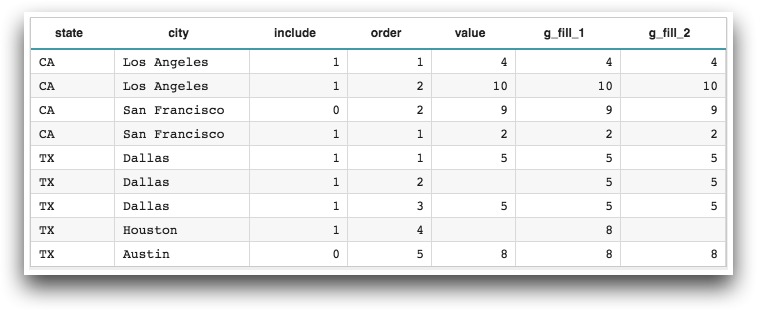g_fill(G;S;O;X;D)
Returns the value of the nearest non-N/A value before or after the current row within a given group.
Function type
Vector only
Syntax
g_fill(G;S;O;X;D)Input
| Argument | Type | Description |
|---|---|---|
G |
any | A space- or comma-separated list of column names Rows are in the same group
if their values for all of the columns listed in If If any of the columns listed in |
S |
integer | The name of a column in which every row evaluates to a 1 or 0, which determines
whether or not that row is selected to be included in the calculation If
If any of the values in
|
O |
integer | A space- or comma-separated list of column names that
determine the row order within a particular group If
If any of the values in |
X |
integer or decimal | A column name |
D |
integer | A value that indicates the direction in which to look for the nearest non-N/A
value:
Note: This column can only contain a -1 or
1 (or a column containing such values) for every
row.
|
Return Value
For every row in each group defined by G and ordered by O
(and for those rows where S=1, if specified),
g_fill returns the value of the current row in X, if it
is not N/A. Otherwise, if the value of the current row in X is N/A,
g_fill returns:
- the value of the nearest non-N/A value in
Xbefore the current row, ifD=-1 - the value of the nearest non-N/A value in
Xafter the current row, ifD=1
The result is the same data type as X.
Sample Usage
<base table="pub.doc.samples.ref.func.g_func_time_series_sample_usage"/> <willbe name="g_fill_1" value="g_fill(state;include;order;value;1)"/> <willbe name="g_fill_2" value="g_fill(state city;include;order;value;-1)"/>

Additional Information
- The
t_version of this function defaults theGargument and omits theSargument. The default forGis set at table load time based on the organization of the table.
